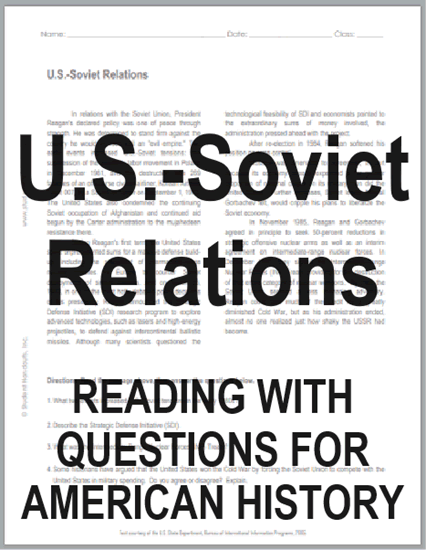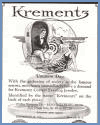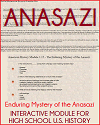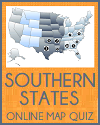| U.S.-Soviet Relations Reading with Questions |
|---|
| www.studenthandouts.com ↣ American History ↣ American History Readings |
In relations with the Soviet Union, President Reagan's declared policy was one of peace through strength. He was determined to stand firm against the country he would in 1983 call an "evil empire." Two early events increased U.S.-Soviet tensions: the suppression of the Solidarity labor movement in Poland in December 1981, and the destruction with 269 fatalities of an off-course civilian airliner, Korean Airlines Flight 007, by a Soviet jet fighter on September 1, 1983. The United States also condemned the continuing Soviet occupation of Afghanistan and continued aid begun by the Carter administration to the mujahedeen resistance there. During Reagan's first term, the United States spent unprecedented sums for a massive defense build-up, including the placement of intermediate-range nuclear missiles in Europe to counter Soviet deployments of similar missiles. And on March 23, 1983, in one of the most hotly debated policy decisions of his presidency, Reagan announced the Strategic Defense Initiative (SDI) research program to explore advanced technologies, such as lasers and high-energy projectiles, to defend against intercontinental ballistic missiles. Although many scientists questioned the technological feasibility of SDI and economists pointed to the extraordinary sums of money involved, the administration pressed ahead with the project. During Reagan's first term, the United States spent unprecedented sums for a massive defense build-up, including the placement of intermediate-range nuclear missiles in Europe to counter Soviet deployments of similar missiles. And on March 23, 1983, in one of the most hotly debated policy decisions of his presidency, Reagan announced the Strategic Defense Initiative (SDI) research program to explore advanced technologies, such as lasers and high-energy projectiles, to defend against intercontinental ballistic missiles. Although many scientists questioned the technological feasibility of SDI and economists pointed to the extraordinary sums of money involved, the administration pressed ahead with the project.After re-election in 1984, Reagan softened his position on arms control. Moscow was amenable to agreement, in part because its economy already expended a far greater proportion of national output on its military than did the United States. Further increases, Soviet leader Mikhail Gorbachev felt, would cripple his plans to liberalize the Soviet economy. In November 1985, Reagan and Gorbachev agreed in principle to seek 50-percent reductions in strategic offensive nuclear arms as well as an interim agreement on intermediate-range nuclear forces. In December 1987, they signed the Intermediate-Range Nuclear Forces (INF) Treaty providing for the destruction of that entire category of nuclear weapons. By then, the Soviet Union seemed a less menacing adversary. Reagan could take much of the credit for a greatly diminished Cold War, but as his administration ended, almost no one realized just how shaky the USSR had become. Directions: Read the text above, then answer the questions below. 1. What two events increased U.S.-Soviet tensions in the early 1980s? 2. Describe the Strategic Defense Initiative (S.D.I.). 3. What was the Intermediate-Range Nuclear Forces (I.N.F.) Treaty? 4. Some historians have argued that the United States won the Cold War by forcing the Soviet Union to compete with the United States in military spending. Do you agree or disagree? Explain. Click here to print this worksheet. Answers will vary. |
 |  |  |  |  |  |
| UNIT I: | Early America | UNIT IX: | Discontent and Reform | ||
| UNIT II: | Colonial Period | UNIT X: | War, Prosperity, and Depression | ||
| UNIT III: | American Revolution | UNIT XI: | New Deal and World War II | ||
| UNIT IV: | New National Government | UNIT XII: | Postwar America | ||
| UNIT V: | Westward Expansion | UNIT XIII: | Decades of Change | ||
| UNIT VI: | Sectional Conflict | UNIT XIV: | New Conservatism | ||
| UNIT VII: | Civil War and Reconstruction | UNIT XV: | Into the Twenty-first Century | ||
| UNIT VIII: | Growth and Transformation | UNIT XVI: | Polarization and Deglobalization |
| www.studenthandouts.com ↣ American History ↣ American History Readings |








